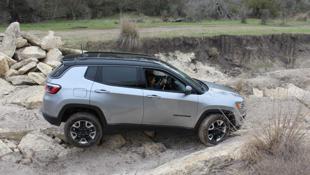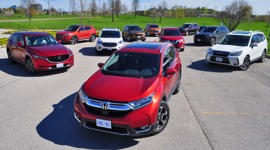San Antonio, TX – The Compass is dead. Long live the Compass.
I would posit this new Compass is the best-looking Jeep in the lineup (leaving the iconic Wrangler aside, of course).
The Jeep Compass (along with its mechanical twin, the Patriot) has occupied the bottom rung of the Jeep ladder since coming on board about a decade ago. Always inexpensive and always feeling that way, this cute-ute with the Jeep badge may have been frowned upon as a lack-lustre wannabe by the off-road cognoscenti, but it nevertheless proved an important product for the brand. Just last year the Compass/Patriot duo accounted for almost 25 percent of Jeep sales in the US.
Production of those two ended in December of 2016, making way for the all-new Mexican-built, world market 2017 Jeep Compass that arrives in showrooms early March. The fact that some of the outgoing cars (also 2017 models) are lingering in showrooms may cause a bit of confusion, but in reality, Compass version 2.0 is pretty much a complete departure from the original. You won’t get them mixed up.
This fresh Compass shares its basic architecture with the compact Jeep Renegade, but a 2.6-inch wheelbase stretch along with an uptick in styling, refinement, interior quality and general sophistication allows it to leapfrog the Renegade within the Jeep hierarchy, landing between it and the Jeep Cherokee.
As such, the Renegade, with an opening sticker of $21,745 (front drive six-speed stick) is now Jeep’s entry-level model. The 2017 Compass will start at $24,900 for the front-drive Sport with six-speed manual and stretch to the $34,895 Limited. A $32,895 Trailhawk version gives real Jeep off-road bona fides. More on that later.
The volume model in Canada will be the Compass North 4x4 at $30,895, putting it right in the thick of things with top-sellers Hyundai Tucson and Kia Sportage. It should be noted that the $795 Cold Weather Group (heated seats, heated steering wheel and remote start) will be a must-have option, as heated seats aren’t standard.
The 2017 Compass is powered by FCA’s 2.4-litre Tigershark MultiAir inline four that makes 180 horsepower and 175 lb-ft of torque. The two lower trim levels (Sport and North) are available with front-wheel-drive that pairs with a six-speed manual or optional six-peed auto. If you want a manual transmission with all-wheel-drive, only the Sport trim offers that. Otherwise, any 2017 Compass with all-wheel-drive goes with a class-exclusive 9-speed automatic transmission.
I would posit this new Compass is the best-looking Jeep in the lineup (leaving the iconic Wrangler aside, of course). It borrows many cues from the Grand Cherokee, adding its own unique flourishes, most notably the shoulder line up-kick and sweeping roofline that gets accented with a slash of chrome or satin metal. Adding to the interest is the gloss black roof and A-pillar, a feature that adorned many of the test cars here (not available on Compass Sport).
Up front we see the classic seven-slot grill, mounted high and flanked by squinty headlights. The whole package looks chunky and well resolved, with trapezoidal wheel openings completing the picture.
The Trailhawk is identified by its satin metal trim, red tow hooks, skid plates, increased ride height (21.6 cm of ground clearance) and unique front fascia for those all-important approach angles. It also gets knobby all-terrain tires and a full size spare.
The Compass’ cabin continues the theme we’ve seen in the Renegade and Cherokee, but the material quality and general ambience raise the bar. There are plenty of soft touch surfaces along with some interesting colour pallets that give respite to the de rigeur coal-bin black. Ergonomics are good, with glove-friendly knobs and buttons. Base models run with a 5-inch Uconnect screen, with 7 and 8.4 inchers available. All have pinch and zoom along with Apple CarPlay and Android Auto. The 8.4-inch Uconnect in our Limited showed sharper graphics for 2017 and continues as one of the best systems in the biz.
Standard on all 4x4 models is Selec-Terrain. Controlled by a rotary knob ahead of the shifter, it offers up to five drive modes: Auto, Snow, Sand, Mud and Rock (Trailhawk only). The 4x4 system is dubbed Jeep Active Drive and can send up to 100 percent of available torque to any one wheel when needed. Conversely, when not needed, the rear drive portion of the system will completely decouple for improved efficiency. Also standard on the 2017 Compass is a, er… compass. Sounds silly, but Jeep got ribbing for not providing that as standard on the outgoing Compass. You’ll also find some “Easter Eggs” in here too – a gecko and the Loch Ness Monster – but I ain’t tellin’ where.
New to Compass are available forward collision warning/mitigation, lane departure warning with corrective action, and adaptive cruise control.
Immediate on-road impressions are good. Indeed, this Compass is heavier than the outgoing model and feels it (also a bit shorter and wider), but it’s more a sense of substance than burden. Body control is good and the ride is Jeep-firm yet refined and never crashy – specially tuned Koni dampers play a part in this. We found the brakes initially grabby but your foot soon acclimatizes. The steering is reasonably dirpossect and accurate, and, as long as you don’t play sports-car in the twisties the Compass is a decent handler. Understeer shows up early if you start overdriving in the bends.
What you won’t be winning is any drag races. The Compass is fine when tooling at a relaxed pace, but calling for bursts of acceleration requires some patience. The nine-speed auto is reluctant to kick down and the 180-hp four pot feels like it’s working against some Sasquatch-like mass.
This wouldn’t be a real Jeep event if we didn’t partake in some eye-opening off-roading. Arriving at Flat Rock Ranch, we subjected a posse of Compass Trailhawks to a course that had us cocking wheels like a dog at a fire hydrant, crawling up impossible inclines and sliding down rock faces. Stuff that few Compasses will ever encounter (barring Armageddon at the mall), but dammit if this little critter will do it all.
Starbucks bragging rights include Active Drive Low all-wheel-drive with 4.33:1 final drive and a stump pulling 20.4:1 first gear crawl, a 30.3 inch approach angle, hill decent control and the ability to ford up to 19 inches of standing water.
Of more importance to buyers will be the accommodating rear seats. The cargo area behind features an adjustable floor and is more commodious than that in the next-size-up Jeep Cherokee. The back seat (either 60/40 or 40/20/40) easily flips forward to create a flat-ish floor. Properly equipped, the 2017 Jeep Compass will tow 2,000 lbs – up by 500 lbs on its direct competitors.
The 2017 Jeep Compass comes across as capable, well sorted, comfortable, stylish and refined – the best of Jeep’s small-ute trio in my opinion. Granted, it might not be the cheapest, the fasted nor the most fuel efficient in this category (NRC numbers pending), but the Compass is pure Jeep. And that is something no competitor can claim.






































